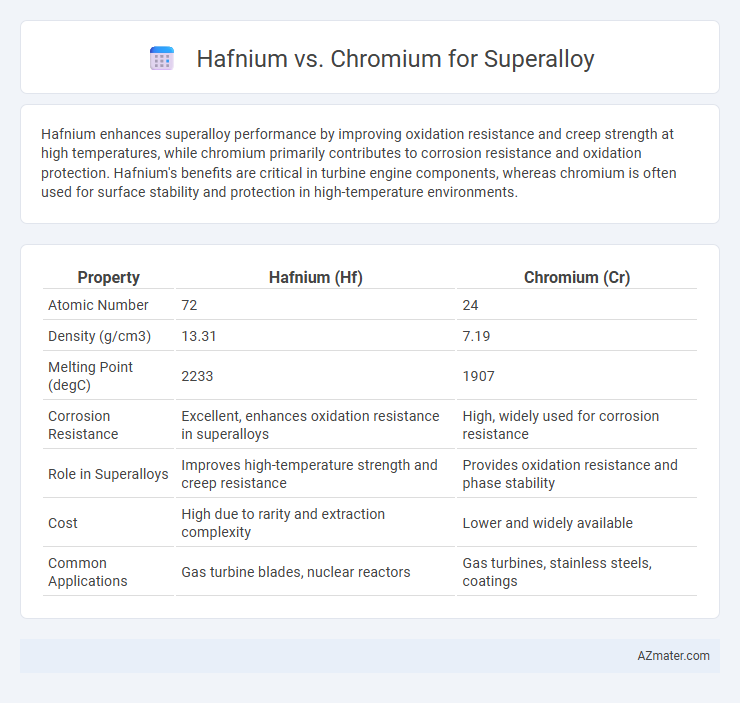Hafnium enhances superalloy performance by improving oxidation resistance and creep strength at high temperatures, while chromium primarily contributes to corrosion resistance and oxidation protection. Hafnium's benefits are critical in turbine engine components, whereas chromium is often used for surface stability and protection in high-temperature environments.
Table of Comparison
| Property | Hafnium (Hf) | Chromium (Cr) |
|---|---|---|
| Atomic Number | 72 | 24 |
| Density (g/cm3) | 13.31 | 7.19 |
| Melting Point (degC) | 2233 | 1907 |
| Corrosion Resistance | Excellent, enhances oxidation resistance in superalloys | High, widely used for corrosion resistance |
| Role in Superalloys | Improves high-temperature strength and creep resistance | Provides oxidation resistance and phase stability |
| Cost | High due to rarity and extraction complexity | Lower and widely available |
| Common Applications | Gas turbine blades, nuclear reactors | Gas turbines, stainless steels, coatings |
Introduction to Superalloys: Importance in Modern Industry
Superalloys featuring hafnium exhibit enhanced high-temperature strength and oxidation resistance, making them vital for aerospace and power generation applications. Chromium contributes significantly to corrosion resistance and surface stability in superalloys, improving durability under extreme conditions. The combination of hafnium and chromium in superalloys optimizes both mechanical performance and alloy longevity in critical industrial components.
Overview of Hafnium: Properties and Benefits
Hafnium is a transition metal known for its high melting point of 2233degC and exceptional corrosion resistance, making it ideal for superalloy applications. It enhances alloy strength, creep resistance, and oxidation stability at elevated temperatures, critical for aerospace and power generation industries. Unlike chromium, hafnium offers superior phase stability and improves grain boundary cohesion, resulting in longer component life under extreme operating conditions.
Overview of Chromium: Properties and Benefits
Chromium is a transition metal with excellent corrosion resistance, high melting point (1907degC), and strong oxidation resistance, making it invaluable in superalloy applications. Its ability to form a stable oxide layer significantly enhances the durability and thermal stability of superalloys used in high-temperature environments such as aerospace and power generation. Chromium also improves hardness, tensile strength, and wear resistance, contributing to the overall performance and longevity of superalloy components.
Hafnium’s Role in Superalloy Performance
Hafnium plays a crucial role in enhancing superalloy performance by improving high-temperature strength, oxidation resistance, and creep properties. Its ability to form stable oxides and carbides strengthens grain boundaries, reducing grain boundary sliding and improving overall mechanical stability at elevated temperatures. Hafnium's presence also contributes to better phase stability and microstructural integrity in superalloys compared to chromium, which primarily provides corrosion resistance but lacks equivalent strengthening effects.
Chromium’s Contribution to Superalloy Strength
Chromium significantly enhances superalloy strength by improving oxidation resistance and promoting the formation of a stable and protective oxide layer, which is essential for high-temperature applications. Its ability to increase corrosion resistance and maintain mechanical integrity under extreme thermal stress makes it critical in superalloy formulations. While hafnium contributes to grain boundary strengthening, chromium's role in surface protection and durability directly impacts the overall performance and lifespan of superalloy components.
Comparative Analysis: Thermal Stability of Hafnium vs. Chromium
Hafnium exhibits superior thermal stability compared to chromium in superalloys, maintaining its strength and oxidation resistance at temperatures exceeding 1,200degC. Chromium tends to form protective oxide layers but may degrade in mechanical performance under prolonged high-temperature exposure above 1,000degC. Hafnium's higher melting point (2,233degC) and strong carbide formation contribute to enhanced creep resistance and thermal stability in extreme environments.
Corrosion Resistance: Hafnium vs. Chromium in Superalloys
Hafnium enhances superalloy corrosion resistance by forming stable oxide layers that protect against high-temperature oxidation and hot corrosion, particularly in turbine engines. Chromium contributes significantly to corrosion resistance through the formation of a protective chromium oxide scale, improving resistance to oxidation and sulfidation in superalloys. Compared to chromium, hafnium offers superior performance in reducing oxide scale spallation and maintaining protective barriers under extreme thermal and corrosive environments.
Cost and Availability Considerations
Hafnium offers superior high-temperature stability and oxidation resistance for superalloys but comes at a significantly higher cost due to its rarity and complex extraction process, making it less economically viable for large-scale applications. Chromium is more abundant and affordable, providing good corrosion resistance and enhancing mechanical properties, which makes it a preferred choice for cost-sensitive superalloy production. The decision between hafnium and chromium hinges on balancing performance requirements with budget constraints and material availability.
Applications: Industry-Specific Uses of Hafnium and Chromium Superalloys
Hafnium superalloys are predominantly used in aerospace and nuclear industries due to their exceptional high-temperature performance, oxidation resistance, and neutron absorption properties, making them ideal for turbine blades and reactor control rods. Chromium superalloys excel in chemical processing and automotive applications where corrosion resistance and wear resistance at elevated temperatures are critical, such as in heat exchangers and exhaust systems. The distinct thermophysical characteristics of hafnium and chromium enhance the thermal stability and mechanical strength of superalloys tailored for these specialized industrial environments.
Future Prospects and Research Directions
Hafnium shows promise over chromium in superalloys due to its superior high-temperature phase stability and improved creep resistance, essential for next-generation gas turbine engines. Ongoing research targets optimizing hafnium microalloying levels to enhance oxidation resistance and mechanical strength while minimizing cost and density impacts. Future studies focus on advanced computational modeling and experimental validation to tailor hafnium-chromium combinations for ultra-high-temperature applications in aerospace and energy sectors.

Infographic: Hafnium vs Chromium for Superalloy
 azmater.com
azmater.com